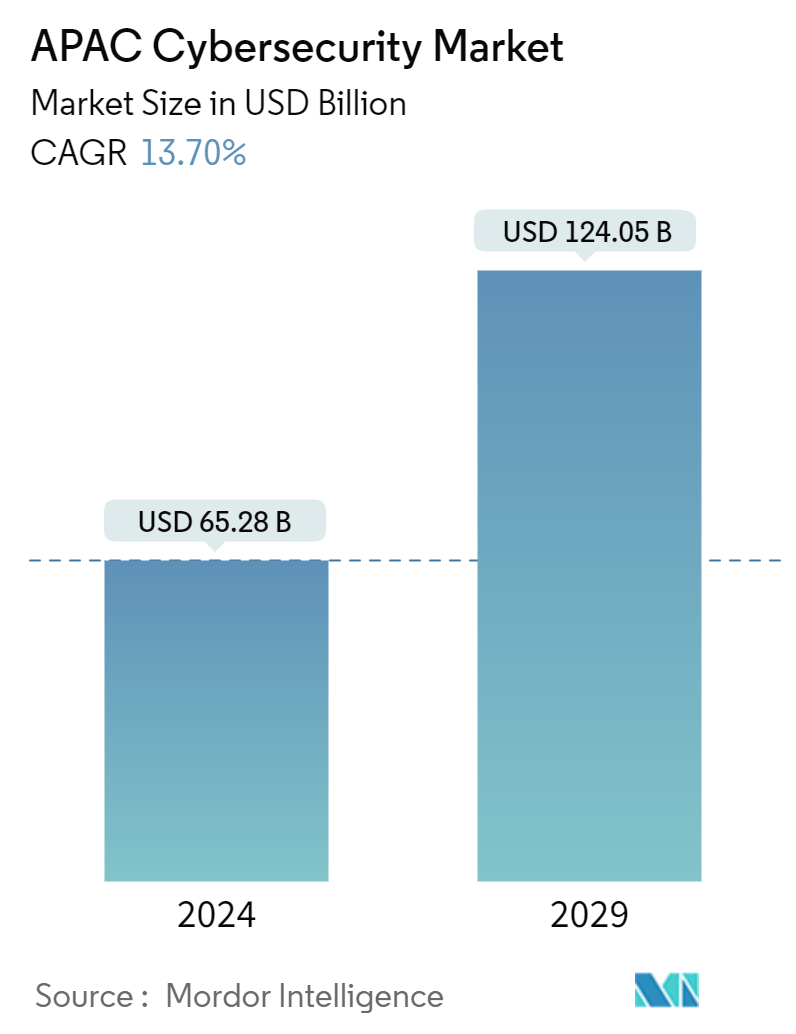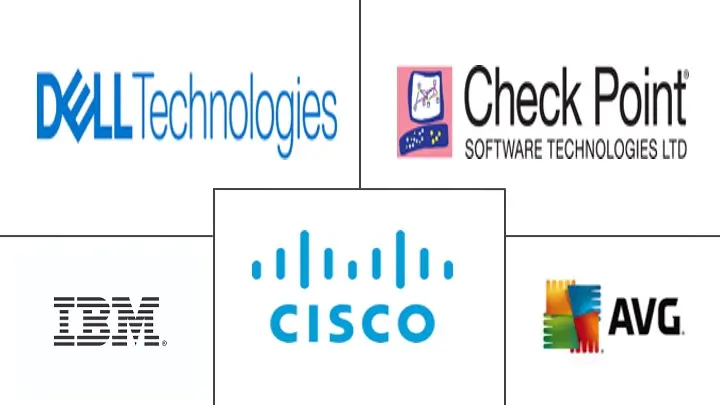Market Size of APAC Cybersecurity Industry

| Study Period | 2019 - 2029 |
| Base Year For Estimation | 2023 |
| Market Size (2024) | USD 65.28 Billion |
| Market Size (2029) | USD 124.05 Billion |
| CAGR (2024 - 2029) | 13.70 % |
| Market Concentration | Medium |
Major Players
*Disclaimer: Major Players sorted in no particular order |
Asia Pacific Cyber Security Market Analysis
The APAC Cybersecurity Market size is estimated at USD 65.28 billion in 2024, and is expected to reach USD 124.05 billion by 2029, growing at a CAGR of 13.70% during the forecast period (2024-2029).
Due to the advent of IoT and the growing speed and scope of digital transformation in this region, the current network infrastructure is becoming more exposed to cyberattacks. Internet, social media, and mobile users have all seen significant increases in recent years, contributing to the region's strong rise in cybersecurity. The Asia-Pacific cybersecurity industry is expected to expand even more due to the increasing severity of these attacks and strict government laws.
- The growing internet usage in both developed and developing countries increases the adoption of cybersecurity solutions. Additionally, due to increased data susceptibility brought on by the expansion of the wireless network for mobile devices, cybersecurity has become a crucial component of every organization.
- Many emerging countries, such as India, China, Singapore, and Japan, face increasing cybersecurity-related issues. India ranks third in the number of DNS hijacks, indicating a sharp rise in cybercrime registration. Additionally, Asia received 26% of all worldwide attacks in 2021, according to IBM X-Force Threat Intelligence Index 2022, making it the most attacked area globally. India tops the list of the most frequently attacked country in Asia. Recent research by the Australian Cyber Security Growth Network entitled the cybersecurity sector might triple in size over the next ten years.
- Although there have been several cybersecurity events in recent years, most of them have remained hidden. Recent high-profile incidents that significantly impacted many common persons have brought public conversation and government and regulatory body attention to the forefront. For Instance, CERT-In, India's official cybersecurity organization, issued a direction relating to Information security practices, procedures, prevention, response, and reporting of cyber incidents for safe and trusted internet to impose stringent cybersecurity reporting requirements. It stated that India had recorded over 2.12 lakh cybersecurity incidents as of February 2022.
- The industry is being driven by new business models and applications as well as reducing device costs, such as an increasing number of connected devices, including consumer electronics, connected cars, factories, etc., which is driving the adoption of IoT and strengthening cybersecurity in enterprises. So, The adoption of M2M/IoT connections drives the cybersecurity market.
- Low preparedness and a high reliance on conventional authentication techniques are challenging. In a market environment where security professionals advise identity-management solutions like facial recognition and biometric identification, more than 80% of organizations still rely solely on usernames and passwords for login, which could challenge growth.
Asia Pacific Cyber Security Industry Segmentation
IT advancements, communication technologies, and smart energy grids are transforming the landscapes of nearly every country's essential infrastructure and commercial networks. Rapidly changing technology, however, brings with it rapidly advancing hazards. Cybersecurity solutions assist a company in monitoring, detecting, reporting, and countering cyber threats, which include internet-based attempts to damage or disrupt information systems and hack crucial data using spyware and malware, as well as phishing to protect data confidentiality. The study's market size is based on end-user spending on cybersecurity systems and services.
The Asia Pacific Cybersecurity Market is segmented by product type (solutions, services), by deployment (on-cloud, on-premises), by end-user industry (aerospace and defense, banking, financial services, and insurance, healthcare, manufacturing, retail, IT and telecommunication), and by country (China, India, Japan, South Korea, Rest of Asia Pacific). The report offers market forecasts and size in value (USD) for all the above segments.
| By Product Type | ||||||||||
| ||||||||||
| Services |
| By Deployment | |
| On-cloud | |
| On-premises |
| By End-user Industry | |
| Aerospace and Defense | |
| Banking, Financial Services, and Insurance | |
| Healthcare | |
| Manufacturing | |
| Retail | |
| IT and Telecommunication | |
| Other End-user Industries |
| By Country | |
| China | |
| India | |
| Japan | |
| South Korea |
APAC Cybersecurity Market Size Summary
The Asia-Pacific cybersecurity market is experiencing significant growth, driven by the rapid expansion of digital transformation and the Internet of Things (IoT) in the region. As internet, social media, and mobile usage surge, the region's network infrastructure becomes increasingly vulnerable to cyberattacks, prompting a heightened demand for robust cybersecurity solutions. The market is further bolstered by stringent government regulations and the escalating severity of cyber threats. Countries like India, China, Singapore, and Japan are at the forefront of this growth, facing unique cybersecurity challenges that necessitate advanced protective measures. The shift towards cloud-based solutions is also a key trend, as organizations seek to enhance security while optimizing costs and resources. This transition is supported by the increasing adoption of on-demand security services, which are becoming integral to business operations.
The market landscape is characterized by a semi-fragmented structure, with major players engaging in strategic initiatives such as mergers, acquisitions, and partnerships to strengthen their market position. Notable investments, such as IBM's Security Command Center in India, highlight the focus on enhancing security incident response and training capabilities. Collaborative efforts, like the Memorandum of Understanding between the Monetary Authority of Singapore and Mastercard, aim to bolster cybersecurity resilience in the financial sector. Additionally, philanthropic initiatives, such as Google's funding for the APAC Cybersecurity Fund, seek to empower underserved businesses with enhanced cyber capabilities. These developments underscore the region's commitment to advancing cybersecurity infrastructure and fostering a secure digital environment.
APAC Cybersecurity Market Size - Table of Contents
-
1. MARKET INSIGHTS
-
1.1 Market Overview
-
1.2 Industry Value Chain Analysis
-
1.3 Industry Attractiveness - Porter's Five Forces Analysis
-
1.3.1 Bargaining Power of Suppliers
-
1.3.2 Bargaining Power of Consumers
-
1.3.3 Threat of New Entrants
-
1.3.4 Threat of Substitute Products
-
1.3.5 Competitive Rivalry within the Industry
-
-
1.4 Industry Guidelines and Policies
-
1.5 Assessment of the Impact of the COVID-19 on the Market
-
-
2. MARKET SEGMENTATION
-
2.1 By Product Type
-
2.1.1 Solutions
-
2.1.1.1 Identity and Access Management
-
2.1.1.2 Threat Detection and Prevention (Unified Threat Management and Threat Mitigation)
-
2.1.1.3 Security and Vulnerability Management
-
2.1.1.4 DDoS Mitigation
-
2.1.1.5 Next Generation Firewall
-
2.1.1.6 IDS/IPS
-
2.1.1.7 Security Information and Event Management
-
2.1.1.8 Other Solutions
-
-
2.1.2 Services
-
-
2.2 By Deployment
-
2.2.1 On-cloud
-
2.2.2 On-premises
-
-
2.3 By End-user Industry
-
2.3.1 Aerospace and Defense
-
2.3.2 Banking, Financial Services, and Insurance
-
2.3.3 Healthcare
-
2.3.4 Manufacturing
-
2.3.5 Retail
-
2.3.6 IT and Telecommunication
-
2.3.7 Other End-user Industries
-
-
2.4 By Country
-
2.4.1 China
-
2.4.2 India
-
2.4.3 Japan
-
2.4.4 South Korea
-
-
APAC Cybersecurity Market Size FAQs
How big is the APAC Cybersecurity Market?
The APAC Cybersecurity Market size is expected to reach USD 65.28 billion in 2024 and grow at a CAGR of 13.70% to reach USD 124.05 billion by 2029.
What is the current APAC Cybersecurity Market size?
In 2024, the APAC Cybersecurity Market size is expected to reach USD 65.28 billion.

